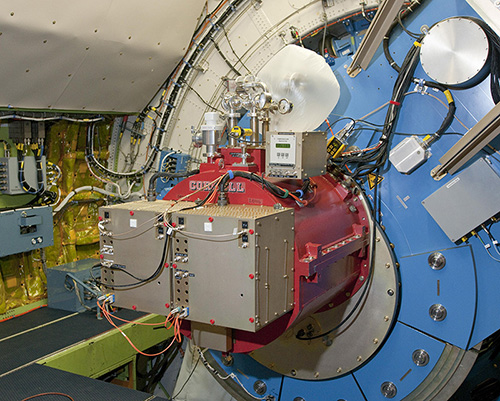Faint Object infraRed CAmera for the SOFIA Telescope (FORCAST)
Facility class Science Instrument
Principal Investigator:
Terry Herter
Cornell University, Ithaca, NY, USA
FORCAST was a dual-channel mid-infrared camera and spectrograph sensitive from 5 – 40 μm. Each channel consisted of a 256x256 pixel array that yielded a 3.4'x3.2' instantaneous field-of-view with 0.768'' pixels, after distortion correction. The Short Wave Camera (SWC) used a Si:As blocked-impurity band (BIB) array optimized for λ < 25 μm, while the Long Wave Camera's (LWC) Si:Sb BIB array was optimized for λ > 25 μm. Observations could be made through either of the two channels individually or, by use of a dichroic mirror, with both channels simultaneously across the entire range. Spectroscopy was also possible using a suite of grisms, which provided coverage from 5 – 40 μm with a low spectral resolution of R = λ/Δλ ≈ 200.
Primary Reference
"FORCAST: A Mid-Infrared Camera for SOFIA"
Herter, et al., 2018, JAI, 7, 1840005-451.
DOI:
10.1142/S2251171718400056
; ADS Bibliographic Code:
2018JAI.....740005H
Handbook for Archive Users
Tutorials
FORCAST Imaging Tutorial: Europa
FORCAST Spectroscopy Tutorial: NGC 7009, The Saturn Nebula
FORCAST Imaging
I.
Aperture Photometry (basic)
Aperture photometry on flux-calibrated FORCAST images (FITS files) using python and astropy.
II.
Aperture Photometry (detailed)
A more detail explanation of the steps involved with aperture photometry using FORCAST data.
III.
Periodic Noise Handling
How to clean up ringing background noise in FORCAST with a data file.
FORCAST Grism Spectra Series
I.
Basic Inspection and Assessment
Python tutorial on plotting and analyzing data.
II.
Basic Line Analysis
Includes minor "cleaning" of the LEVEL_3 data and then some basic emission line analysis including continuum fitting and subtraction, line flux measurement, and simple line fitting.
III.
Custom Spectral Extraction
Utilizes Level 2 two-dimensional images to plot the aperture and do a simple custom extraction using a different aperture.
